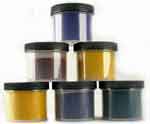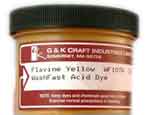How to dye a wool blend coat with Rit All-Purpose dye
Name: Tessa
—ADVERTISEMENTS—

Lanaset Dyes are among the very best dyes for hand-dyeing wool, silk, angora, mohair, and most nylons. You will also need: citric acid, sodium acetate, Glauber salt, Albegal SET, and Synthrapol.
Buy from
Paradise Fibers
at Paradise Fibers

Washfast Acid dyes
Also known as Nylomine dyes, excellent for use on nylon. One ounce of dye will dye six pounds of fiber!

Columbian Home 33-Quart Jar Canner and Rack
An enameled canner works well as a dyeing pot. Avoid aluminum pots for dyeing, because they react with the vinegar. Do not reuse a pot for cooking food after dyeing in it with Rit or other dyes.
Country or region: California
Message: I searched all over your site, and got very good information, but just wanted to make sure I'm doing this with the certainty it won't be a disaster. I have a peacoat, that is 60% wool and 40% polyester, and I would like to dye it dark green, and I have purchased 3 bottles of the green Rit dye. I have used Rit before, but on denim, which I can wash after with no worry, but with this coat, I am not sure how to do the whole process.
I have been looking on the web for ages trying to find information on how to do it, and your site is the closest I have ever come to it.
Please Help me!
There can be no certainty that it won't be a disaster. There are a lot of potential problems:
- Your wool coat might shrink or felt.
- The polyester will not take any of the dye, so the color will only be 60% as dark as you would get if you dyed 100% wool. (Don't even try polyester dyes on polyester-wool blends, because they require much more boiling.)
- Rit All-Purpose dye sometimes produces unexpected colors; it's less reliable than buying a good acid dye for wool.
- The coat might have invisible stains that will resist dye, resulting in one or more random undyed splotches.
- It works much better to use a large cooking pot to heat your wool in. If your cooking pot is not large enough for the coat to move in freely when you stir it, you should expect uneven results, a little like tie-dyeing.
- You probably don't want to dye wool in the washing machine, because the agitation is likely to cause shrinkage. Use the washing machine only if it has a extra-delicate "hand-wash" setting that will allow you to do so without much agitation.
- You should not use an aluminum cooking pot, since aluminum reacts badly with vinegar and other acids.
- You should not use a cooking pot that you will reuse for food, because Rit and other textile dyes are not safe to use on food preparation equipment.
- Dark green dye will color your coat green only if the coat is white to begin with, or if it is light blue, green, or yellow; dye cannot cover up dark colors.
If you decide to go ahead with this project, in spite of the risks, you must first wash the coat thoroughly. Is the coat washable? Try washing it, and see if it survives. Avoid agitation and sudden temperature changes, which are likely to cause shrinkage or damage to the wool. You need to gradually increase the temperature of your dyebath in order to reach the temperature at which the dye will bond to the fiber.
I recommend that you try this only on a coat that you're not interested in wearing again in its current undyed state. It's always possible that you will ruin your coat when you try to dye it.
Rit says that, for dark colors such as Dark Green, you should use one bottle of liquid Rit dye per pound of fabric. (That's twice as much as is required for lighter colors.) For each pound of wool fabric, use one bottle of liquid Rit dye (use more for a darker color), three gallons of water, and one cup of white vinegar; wait to add the vinegar to your dyebath until five minutes or more after combining the fabric with the dye and water. The vinegar helps wool to accept the dye, and it helps to protect the wool from becoming damaged and rough due to the high pH of the detergent ingredients in the Rit dye as packaged.
If your coat is heavy, you're unlikely to find a stainless or enamel cooking pot large enough to dye it in. For a four-pound coat, you should allow at least twelve gallons of water (according to Rit's instructions); I'd rather use at least twice that much water, for a solid level color. Here are the steps to follow:
- Prewash the coat. You cannot dye anything that you have not first washed thoroughly. If it's not washable, it's not dyeable.
- Weigh your coat, while it is dry, to decide how much water and dye you will need. (After weighing it, place it into water to soak so that it will get thoroughly wet before you dye it; a single drop of Synthrapol or hand dishwashing liquid will help the water to penetrate the wool.)
- Multiply the number of pounds the wool coat weighs by three, to find the minimum number of gallons of water you will need.
- If this number is less than 8, buy a 33-quart enamel canning pot to use as a dyeing pot; 33 quarts is the largest size of non-aluminum cookware that is easy to find (look at your local hardware store, or look on Amazon). Used cookware is fine as long as there are no rusty spots or scratches inside. You will not reuse this pot for food after dyeing in it.
- If the number of gallons needed is too large for you to be able to find a suitable size of cooking pot, then you will not be able to heat your dyebath. Find a large bucket or new clean plastic trash can that is large enough to hold the required amount of water, allowing three gallons or more for each pound of fabric. You will probably want to place it either inside the bathtub or shower, or outside (though not near a concrete walkway that can stain), since it will be too heavy to lift once you fill it with water. If possible, find some way to insulate the plastic container so that the dyebath will cool less quickly: wrap it in bubble-wrap or other insulation. It is helpful to place an insulating layer under the container so that it does not lose heat where it contacts the ground, but be careful that the container is steady so that it will not tip.
- Measure the amount of water you need. If you will be using the plastic bucket or trash can, you will need to heat some of the water on the stove, or in a tea kettle, to get it hot enough; your hot tap water is probably not hot enough. It is okay to use your good measuring cups or cooking pot for the clean water, as long as you do not allow dye near them. Remember that one gallon is four quarts, or sixteen cups, or four liters. Try to reach 150°F (that's 66°C), since the water will cool some when you put it into the plastic container; your goal is for the water to be 140°F when you add the wool. Caution: water over 120°F will scald skin on contact, but it works much better for dyeing wool.
- Carefully pour the dye into the water, holding the container just above the surface in order to prevent splashing. (Wear waterproof gloves to protect yourself from the dye and hot water!) If you are using powdered dye, dissolve it in a pint jar of water before adding it to the water.
- Using a long-handled spoon that you will not reuse later for food, or a smooth stick that will not snag your wool, stir the dye in the water until it is evenly mixed. Your stirring spoon or stick needs to be long enough to reach the bottom of the container without getting your hand into the water.
- Add your already-wetted coat to the dyebath. Carefully move it around so that the dye can penetrate evenly, and so that no creases remain in the coat to prevent dye from reaching every part evenly. Stir very slowly and carefully; excessive agitation will cause wool to shrink.
- After five minutes, add the vinegar. Use distilled white vinegar. You will need one cup of vinegar for each pound of fabric. The Rit dye company says to also add one tablespoon of laundry detergent for each pound of fabric, to help level the color. If you have the dyer's detergent Synthrapol on hand, use one teaspoon (5 ml) of it, instead of another laundry detergent.
- Continue to gently move the coat in the dyebath for an hour. Remember that dye will appear lighter after the coat is dry, so you will want it to be very dark in color.
- Allow the wool to cool in the dyebath, then drain off the liquid. It is safe to dispose of it down the drain.
- Rinse the coat in warm water, similar in temperature to the temperature of the dyebath, and then wash in cooler water. Avoid sudden changes in temperature, which will tend to cause shrinkage or felting.
- To reduce the fading suffered by all-purpose dyes such as Rit, follow the dyeing procedure by treating the coat with Retayne, Dharma Dye Fixative, or another commercial dye fixative. Otherwise, be careful to launder the dyed item only in cold water, separately from other garments, or dry clean instead.
(Please help support this web site. Thank you.)
Posted: Friday - May 11, 2012 at 11:44 AM
Follow this blog on twitter here.
- Top of this blog -
- FAQ -
- The Dye Forum -
- How to Tie Dye - How to Batik -
- Books - Toys - Plants -
More in this category:
- -
Total entries in this category:
Published On: Aug 29, 2012 02:49 PM